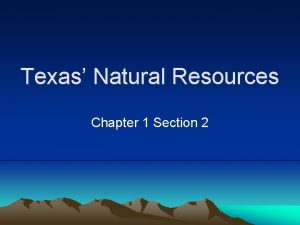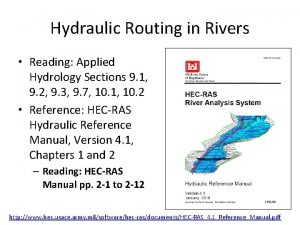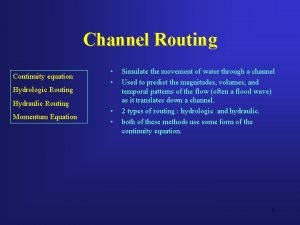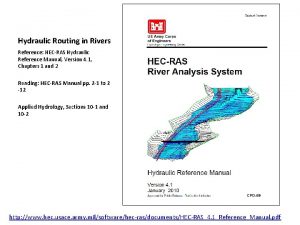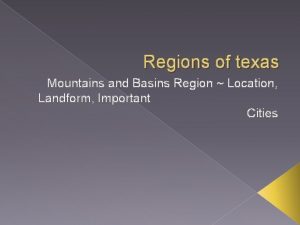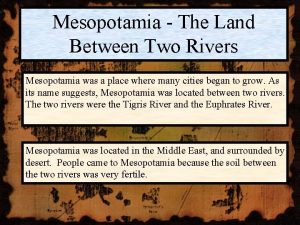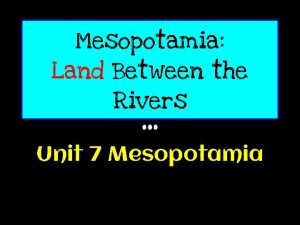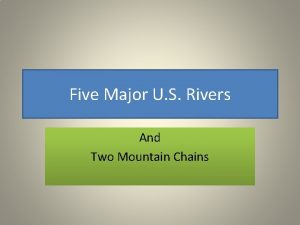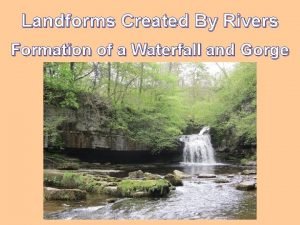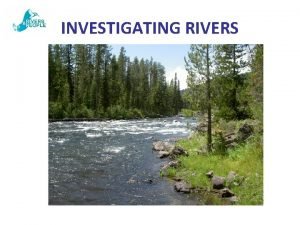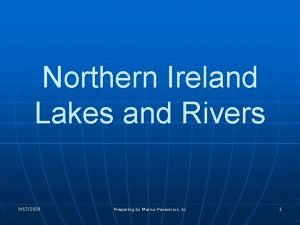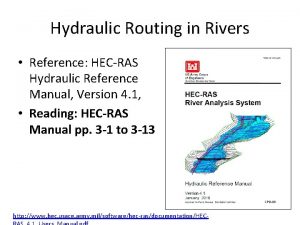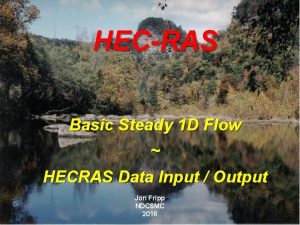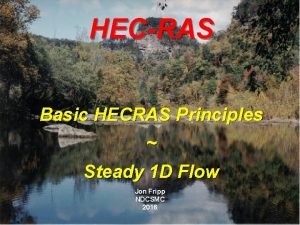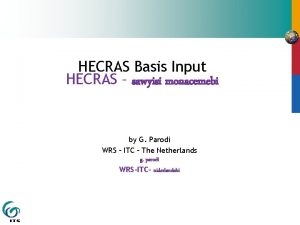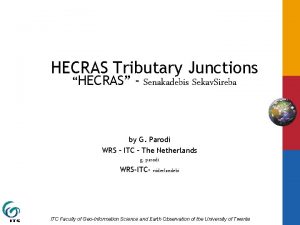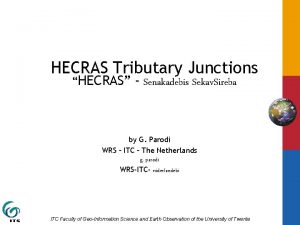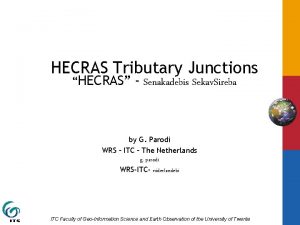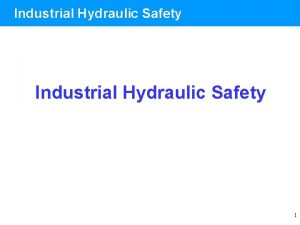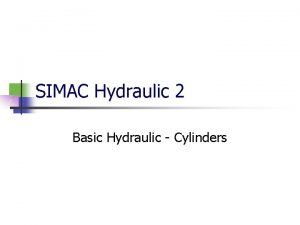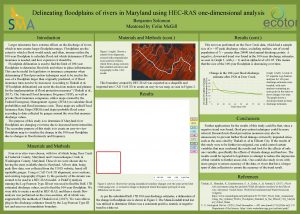Hydraulic Routing in Rivers Reference HECRAS Hydraulic Reference





























- Slides: 29

Hydraulic Routing in Rivers • Reference: HEC-RAS Hydraulic Reference Manual, Version 4. 1, • Reading: HEC-RAS Manual pp. 3 -1 to 3 -13 http: //www. hec. usace. army. mil/software/hec-ras/documentation/HEC-

Flood Inundation

Floodplain Delineation

Steady Flow Solution

One-Dimensional Flow Computations Cross-section Channel centerline and banklines Right Overbank Left Overbank

Flow Conveyance, K Left Overbank Channel Right Overbank

Reach Lengths (1) Floodplain Lob Lch Rob Floodplain (2) Left to Right looking downstream

Energy Head Loss

Velocity Coefficient,

Solving Steady Flow Equations 1. All conditions at (1) are known, Q is known 2. Select h 2 3. compute Y 2, V 2, K 2, Sf, he 4. Using energy equation (A), compute h 2 5. Compare new h 2 with the value assumed in Step 2, and repeat until convergence occurs Q is known throughout reach (A) h 2 h 1 (2) (1)

Flow Computations Reach 3 Reach 2 • Start at the downstream end (for subcritical flow) • Treat each reach separately • Compute h upstream, one crosssection at a time • Use computed h values to delineate the floodplain Reach 1

Floodplain Delineation

Momentum Equation Steady, uniform flow Steady, non-uniform flow Unsteady, non-uniform flow

HMS-RAS Integration Strategy/Workflow Brushy Creek Example Dean Djokic, ESRI 22 March 2012 H&H Using Arc. GIS

Lecture Overview u Approach to integrated H&H model development u Upper Brushy Creek – Geo. HMS/HMS development u Flood modeling for area of interest – Geo. RAS/RAS development H&H Using Arc. GIS 9 -15

HMS-RAS Integration Overview H&H Using Arc. GIS 9 -16

Integration Approach u Mix of planning, GIS, and H&H modeling operations – not a push button operation. u Types of integration u Modeling support (preparing data for model input) w e. g. land use/soils/CN or rainfall processing – Arc Hydro or general GIS data processing u Linked w Geo. HMS w Geo. RAS u Integrated w DSS H&H Using Arc. GIS 9 -17

Integration Approach (2) u Key steps: u Plan (roughly) hydrologic and hydraulic model layouts – flow exchange locations w e. g. location of HMS modeling elements and RAS cross-sections u Identify sources of precipitation input into the hydrologic model and techniques for their incorporation into the dataset w e. g. Nexrad rainfall u Develop Geo. HMS model (and precipitation sub model) u Finalize and run HMS model and generate results (DSS) u Develop Geo. RAS model u Finalize and run RAS taking HMS results as input u Feedback between HMS and RAS is manual w e. g. modification of time of concentration or routing parameters H&H Using Arc. GIS 9 -18

Integration Planning u Identify where outputs from one model (HMS) become input to the second one (RAS) u Place hydrologic elements (subbasins, reaches, junctions) to capture flows at points of interest (confluences, structures) u Place hydraulic elements (crosssections) at points of interest u Identify/specify element naming conventions between the two models (persistent or transient names) H&H Using Arc. GIS 9 -19

Precipitation Sources u Identify sources of precipitation input into the hydrologic model and techniques for their incorporation into the dataset u Point (rain gage) u Polygon u Surface (Nexrad cells) (TIN/grid) H&H Using Arc. GIS 9 -20

Develop Geo. HMS model u Follow all principles in development of a hydrologic model u In addition, take into consideration integration planning aspects developed earlier u Placement u Naming u of flow exchange points conventions Incorporate precipitation submodel u Develop Arc Hydro time series for the final subbasin delineation and export to DSS u Export to HMS H&H Using Arc. GIS 9 -21

Meteorological Component u u Develop a custom “gage” for each subbasin or for each rainfall observation element with corresponding weights for subbasins. Export the time series for the subbasin “gage” from Arc Hydro time series data structure into DSS Arc Hydro to DSS transfer DSS H&H Using Arc. GIS 9 -22

Finalize and Run HMS u Complete HMS model with any additional parameters including meteorological model and control specifications u Follow all principles in HMS model development (calibration, etc. ) H&H Using Arc. GIS 9 -23

Finalize and Run HMS (2) u Do the final run and generate results (DSS) HMS View DSS View H&H Using Arc. GIS 9 -24

Develop Geo. RAS model (pre-processing) u Follow all principles in development of a hydraulic model for element placement (confluences, structures, …) u In addition, take into consideration integration planning aspects developed earlier u Naming conventions (add name of the HMS element to the cross-section that will get the element’s flows) u Export to RAS H&H Using Arc. GIS 9 -25

Finalize and Run RAS u Complete RAS model with any additional parameters including initial and boundary conditions u Follow all principles in RAS model development (calibration, etc. ) H&H Using Arc. GIS 9 -26

Finalize and Run RAS (2) u Do the final run and generate results (export to sdf file) H&H Using Arc. GIS 9 -27

Process RAS results in Geo. RAS u Construct the floodplain based on the results in the sdf u Review the results with respect to spatial integrity (extents of cross-sections, ineffective flow areas, disconnected flood areas, …) u Clean results u Revisit RAS H&H Using Arc. GIS 9 -28

GIS – HMS – RAS Feedback u At present it is manual and at discretion of modeler u GIS u. H u – H&H interaction – H interaction Visualization in both pre and post-processing – not just a “pretty picture” u Fly-over in preprocessing (Geo. HMS and Geo. RAS) w Identification of data problems w Modeling element placement u Post-processing (Geo. RAS) w Validity of element placement H&H Using Arc. GIS 9 -29
 Hydrologic continuity equation
Hydrologic continuity equation Usace hec
Usace hec Why are some rivers in texas called “wrong way” rivers?
Why are some rivers in texas called “wrong way” rivers? Level pool routing
Level pool routing Mark tinka
Mark tinka Comparison of clock routing and power routing
Comparison of clock routing and power routing Hydraulic routing
Hydraulic routing Hydraulic routing methods
Hydraulic routing methods Hec ras reference manual
Hec ras reference manual Reference node and non reference node
Reference node and non reference node Reference node and non reference node
Reference node and non reference node Common and proper noun paragraph
Common and proper noun paragraph See beyond the obvious meaning
See beyond the obvious meaning Landforms in mountains and basins region
Landforms in mountains and basins region Mesopotamia the land between two rivers
Mesopotamia the land between two rivers Four rivers district
Four rivers district 3 rivers optical
3 rivers optical Perfect location
Perfect location Major us rivers
Major us rivers Waterfalls are landforms created by
Waterfalls are landforms created by 3 rivers indian clinic muskogee
3 rivers indian clinic muskogee Investigating rivers
Investigating rivers Symbol of a river
Symbol of a river Dublin urban rivers life project
Dublin urban rivers life project What 2 rivers surround mesopotamia
What 2 rivers surround mesopotamia Only when all the rivers have run dry
Only when all the rivers have run dry Discussion questions about entrepreneurship
Discussion questions about entrepreneurship Guest lecturer in geography
Guest lecturer in geography Longest rivers in asia
Longest rivers in asia What is the longest river in northern ireland
What is the longest river in northern ireland


